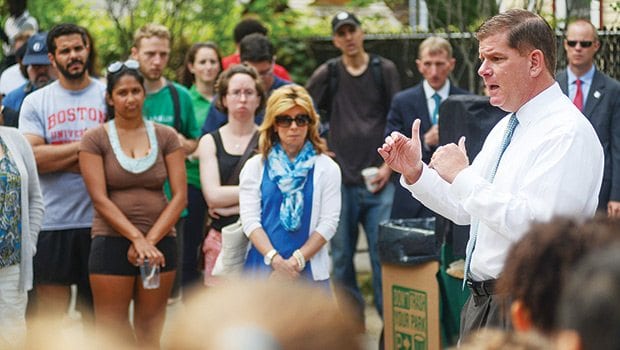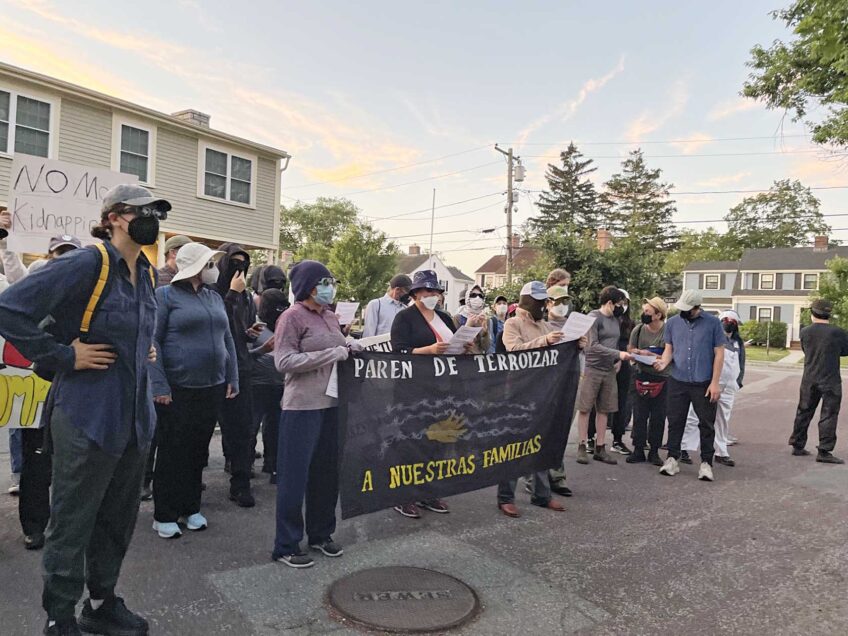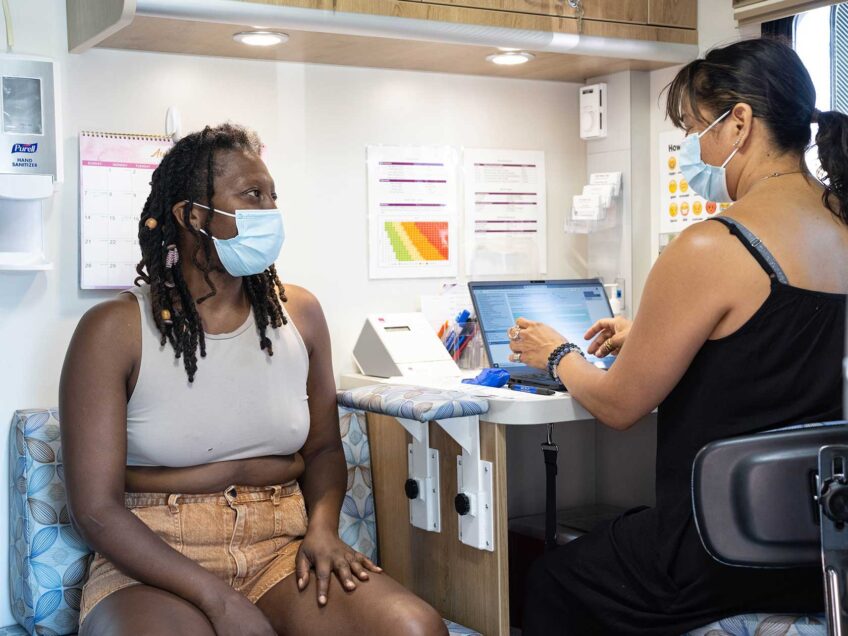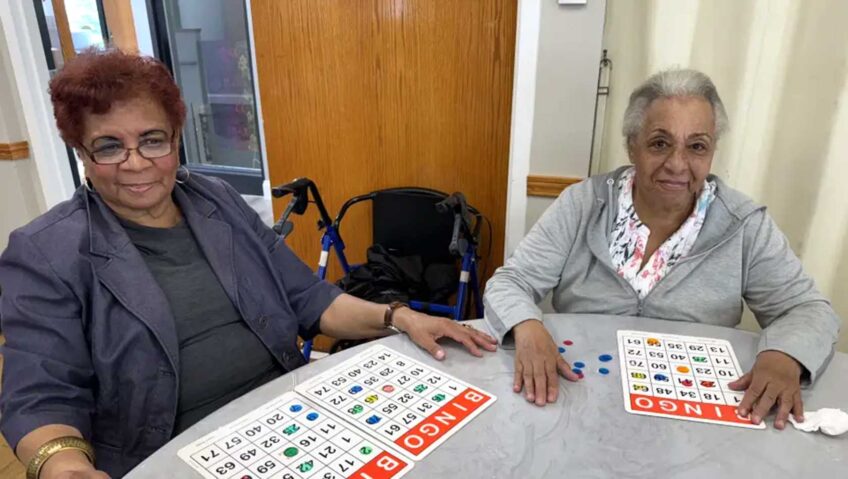Brazen shooting sparks heated discussion
Mayor, community discuss violence, policing

The shooting last week of a seven-year-old boy in the Bowdoin/Geneva neighborhood opened up a local conversation on violence, policing and, tangentially, race.
The issues collided publicly when Mayor Martin Walsh made a much-publicized comment to WBZ in the wake of the shooting.
“What’s sad is there’s no outrage or protest about a 7-year-old being shot,” he said. “There’s some protests around the country with police officers’ interaction with people, I think some of those protests, we need to start looking at our neighborhood and say, ‘what do we need to do to get the guns off our streets.’”
Walsh’s comments came as the Wall Street Journal last week released a report detailing nearly 400 police shootings so far this year, with half of all victims people of color. Among the unarmed victims of police shootings, two thirds were black and Latino. Overall, blacks were killed at three times the rate of whites and other minorities.
Walsh’s comment brought swift reaction from many who viewed his words as a dig at protesters who have focused this year on police violence against people of color. Others were quick to point out the countless community organizations that work against youth violence in the area on a daily basis.
At a Jamaica Plain coffee hour meeting at Brewer-Burroughs park last Thursday morning, the repercussions of that comment reverberated as some young activists used the opportunity to ask him about that statement.
The mayor responded by distancing himself from his original statement.
“People are upset in Bowdoin-Geneva,” he said. “They work hard … [and] it’s a random act of violence. … People should be angry and they are angry.”
He said that his reference to a lack of anger was a criticism aimed at community members who might have information about the shooting but thus far have declined to share it with law enforcement.
“People should get angry and no one’s talking about it. … No one’s talking to the police,” he said, adding he felt confident someone had seen the shooter.
The Banner asked specifically whether his original statement had been in reference to the Black Lives Matter movement.
“Absolutely not,” Walsh said.
BLM weighs in
Walsh’s statements did not sit well with local Black Lives Matter organizers.
“I thought the mayor’s initial comments were both callous and completely ludicrous,” said Seneca Joyner, one of the organizers of Boston’s Black Lives Matter group, when reached by the Banner via email. “He suggests that black people don’t really care about other black people. Such sentiments are racist.”
She added that she also was not convinced by his follow-up explanation on the matter.
“His ‘clarifications’ read as particularly ignorant,” she said.
“They’re denying their own culpability in supporting this racist system and instead shifting responsibility for state violence onto our over-policed and under-served communities,” she said.
Joyner’s comments highlighted critiques that people in Boston’s communities of color have long had about the police department, including the suspected role that race plays in homicide investigations.
Boston Police Department spokesperson Lt. Mike McCarthy responded to a Banner request for comment on the matter via email:
“What I can say is that every homicide investigation is unique. As such, every investigation can be different with different outcomes. Some have witnesses, some don’t, some happen inside, some outside, etc. Race is never a factor when conducting an investigation. Nor is any particular neighborhood or section of the city. We go where the investigation takes us.”
Root causes of violence
Aside from policing matters, conversations in the wake of the shooting revealed another issue of concern to many: the root causes that underlie gun violence.

Author: Mayor’s Office photo by Jeremiah RobinsonMayor Martin Walsh answered questions from activists during a Jamaica Plain coffee hour last week after he made remarks questioning the priorities of protesters who demonstrate against police brutality.
The conversation between Walsh and the young activists at the community meeting did show one area of common ground.
“I’m willing to bet a large percentage of those people that have guns don’t have jobs,” Walsh said, eliciting some nods of agreement from the young people gathered around him. “They turn to the streets because they have to. … There’s a root cause.”
Speaking by phone with the Banner, City Councilor Charles Yancey emphasized another element: the need for greater city investments in direct prevention approaches.
“We need to increase the number of street workers, youth workers and mentors,” he said. “There are only 30 street workers for the city of Boston. That’s not sufficient when you consider the number of young people who drop out [of school] every year.”
Yancey proposed, as he has for some time, increasing the number of street workers to 300 – an idea he said was based on the city’s previous experience.
“In the mid-1990s, the street worker program was increased, and there was a significant decease in the level of violence,” he said. “But it was on a pilot basis, so after we achieved success, we decreased the numbers,” he laughed ironically.
He added that many of the same people who caused community violence could be served through targeted prevention programs.
“We spend $50 million per year on police overtime — that’s almost twice the entire budget for Boston Center for Youth and Families [the city’s largest youth and human services agency],” he said. “I really believe it’s a trade-off.”
“The administration is moving in the right direction,” he concluded. “But the approach is far too timid.”
Dangerous trade
Matt Parker, the coordinator for the Boston Public Health Commission’s Violence Intervention and Prevention initiative for the Bowdoin/Geneva area, also spoke with the Banner by phone about the problems facing the community. He said the main source of the problem he saw was the illegal weapons trade driving the violence.
“The accessibility to guns is so high,” he said. “Massachusetts has a lot of restrictions, but it’s not enough to stop the illegal trade.” He said that the problem was perpetuated by a “small percentage of individuals.”
The issue of state firearms laws is evident, for instance, in the drugs-for-guns trade as reported last year by the Boston Globe that stretches between Massachusetts and states with lax gun laws.
And despite the persistent stereotype of such crimes being a “black” problem, the customers fueling such drug trades cut across racial lines — most obviously in the case of a local opioid trade driven overwhelmingly by white drug users, as the Banner covered last month. While heroin was widely considered a “black” drug in the 1970s and 1980s, it is now most prevalent in white communities across Massachusetts.
Looking forward
In terms of hope for the future, Parker sounded a positive note. He said the Bowdoin/Geneva neighborhood has changed significantly since he was growing up there in the mid-1990s.
The greatest driver of change, he said, is an increase in community action on the issue.
“People took ownership in community issues,” he said. He described an incident two weeks ago in which a party was turning violent and some community members intervened to stop it and call the police.
“When people have enough, they will step up and stop it,” he said. “Those types of incidents never get highlighted … but those little moments do happen. That’s cause for celebration.”
He said that in terms of community-police relations, he had also seen improvements.
“Things have gotten better, especially due to more vocal residents,” he said. He noted changes like police bike patrols and a stronger focus on relationship-building with residents through involvement in after school programs and community meetings.
“I say that with an air of caution because nothing is ever 100 percent great, but they’ve [improved],” he said of the police.






